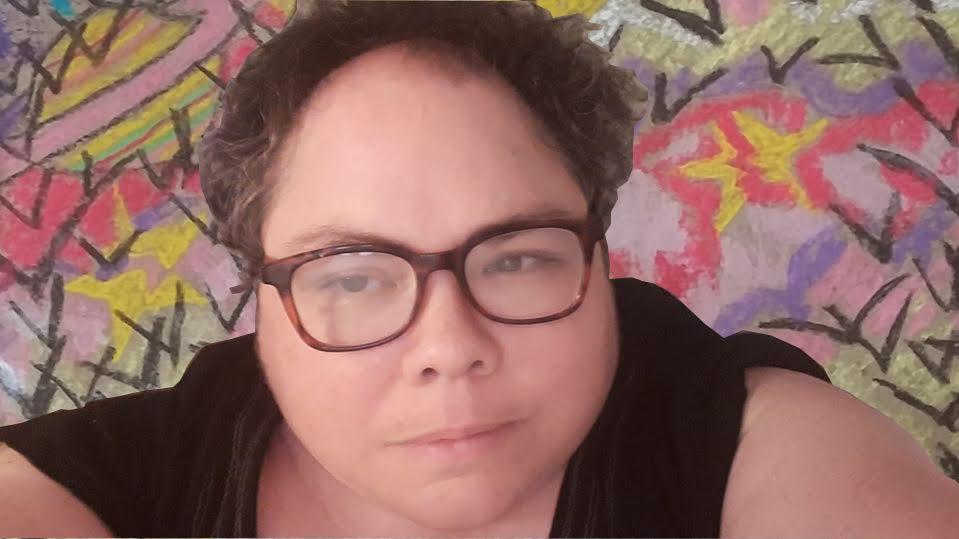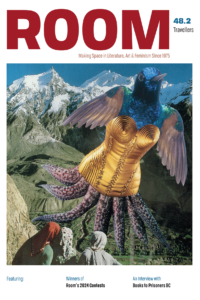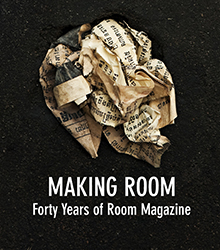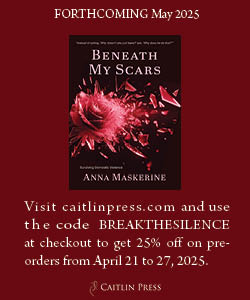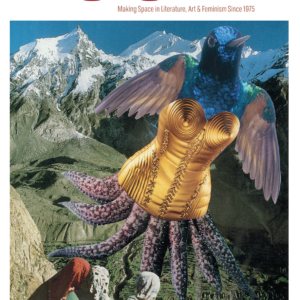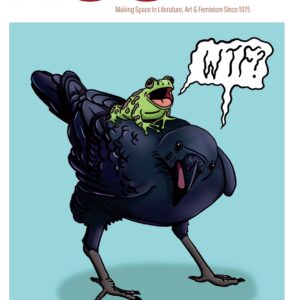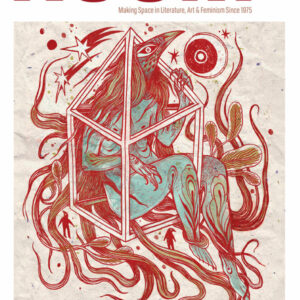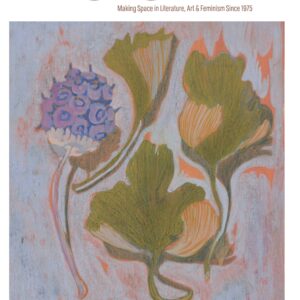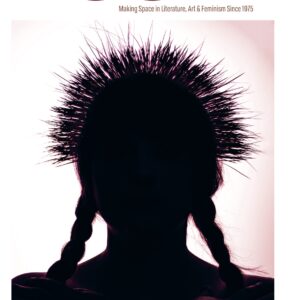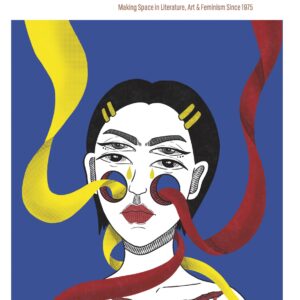Anna Quon is a writer based in Halifax, Nova Scotia. The author of two novels, Migration Songs (Invisible Publishing, 2009) and Low (Invisible Publishing, 2013), her most recent publication is the poetry chapbook, Body Parts (Gaspereau Press, 2021), and she has another novel forthcoming. She has also self-published several poetry chapbooks, and her video poems have been featured online by the Nova Scotia Advocate and a number of film festivals. In what follows, Quon discusses her process, poetics, writing with and without fixed forms, and what it means to her to be a Mad writer, among other subjects.
ROOM: Many of the poems in your new chapbook, Body Parts, feel quite melancholic to me, which makes sense—you’re tackling subjects like death, illness, pain, and climate catastrophe. And yet, you often choose to centre beauty when depicting these difficult experiences. Was this something you sought out to do?
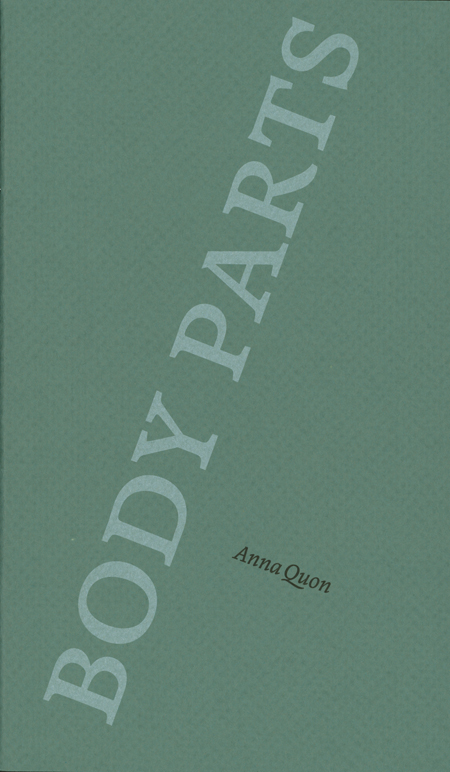 Anna Quon: I think I am almost always aiming for beauty when I write poetry. I guess I’m not sure why I would write a poem about anything if I didn’t want to capture an experience of beauty for myself and other readers. Sounds, imagery, a beautiful idea. That is not to say I don’t appreciate ugliness in poetry, or the unbeautiful, especially as a startling contrast to what is beautiful.
Anna Quon: I think I am almost always aiming for beauty when I write poetry. I guess I’m not sure why I would write a poem about anything if I didn’t want to capture an experience of beauty for myself and other readers. Sounds, imagery, a beautiful idea. That is not to say I don’t appreciate ugliness in poetry, or the unbeautiful, especially as a startling contrast to what is beautiful.
I am glad you find that I centre beauty in my poetry, I think. I’m not sure anymore what makes something beautiful. I used to think I knew. Usually, I write about things I have come to terms with or to some kind of truce with. So I write about them from a place of okayness, with myself and with what happened. So maybe that’s why I can write about difficult things while centring beauty? It’s in the timing—I tend not to write about those difficult things until I feel ready (i.e., in control of the way I express my feelings) and until I have something hopeful to say, so maybe that’s why beauty makes its way to the centre of things. Beauty itself is a hopeful thing to me, so maybe that’s why it is in the middle of things.
ROOM: I find your poetry very visual. When it comes to describing the ineffable—pain, for example—you often turn to figurative language that relies on imagery. Do you think of your process as a visual one? How do you think about imagery in your work?
AQ: I often start with an image when I write anything, from a poem to a novel. I do think of my process as one of feeling my way along with my imagination and my imagination is primarily visual. I also like to paint and make animated films and am not as drawn to music as to visuals. So, I guess my answer to your first question is yes!
I sometimes have difficulty with abstract language. If I can’t see it and feel something about it, it’s hard for me to grasp. So, I think I try to be quite concrete, and usually symbolic. And don’t like to tear these two things apart. For me imagery and symbolism are not devices, they are about the way reality is. I feel that, even though I believe some of my associations are culturally determined. But maybe rather than saying, Okay, that symbol only applies to the culture I come from, it’s kind of a facet or a mirror, showing me something real but only one part or side of it. I like the idea that the truth about anything is multi-faceted. I like to think people see something in their mind’s eye when they read my poetry, maybe a facet they hadn’t seen before, and maybe they look at the world around them a bit differently after that. That’s my hope!
ROOM: On the topic of the ineffable, your poems often seem to recreate experiences that are difficult to describe. I’m thinking of pieces like “Shiftwork,” “I wrote a poem no one else could see,” and “In the Brain Swept Clean of Hope,” which also stand out to me for the way they resist easy interpretation. I’m curious to know how you see these poems, and how you approached writing them?
AQ: “Shiftwork” was inspired by the myth of Persephone, queen of the underworld, who spends half her year apart from her grieving mother Demeter, goddess of the harvest. Also by the idea of women working the night shift. “I wrote a poem no one else could see” is informed by the experience of imagining a poem in my head, which has its own life and character, and doesn’t always do what I want, before it finally leaves me. “In the Brain Swept Clean of Hope” makes reference to an experience of mental unwellness which begins with depression and proceeds to terror and resignation.
Those are the stories and experiences these poems began with, but the poems are their own thing, so they are not about those stories and experiences exactly, but maybe more about the feelings they evoke in me. I like the idea that readers will come up with their own stories about these poems, if they are successful at making readers feel something too.
ROOM: I couldn’t identify any fixed forms in this chapbook, but I know that you write haiku. I really enjoyed A Year in Haiku, a collection of poem cards you self-published that is now out of print. Would you say that this form, or any other forms or poetic traditions, has influenced your writing?
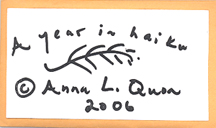 AQ: A Year in Haiku is not really out of print, but I only make copies when I feel like it, if I have an order or am going to sell at a craft show or something.
AQ: A Year in Haiku is not really out of print, but I only make copies when I feel like it, if I have an order or am going to sell at a craft show or something.
I admit that I am not that attracted to traditional forms of poetry usually—not to reading or to writing them. I think it’s because the form often seems to have little or nothing to do with what I’m trying to say, or the experience I think the poet I’m reading is trying to convey. This might just be ignorance on my part… but I often find formal poetry awkward. Still, Japanese haiku attract me for their brevity and natural imagery, and the sense that they capture a fleeting moment that is also eternal. I use the 5-7-5 syllable structure we think of as the haiku form in the West to contain my poems about nature, sometimes just because I think readers will say, “Ooh a haiku! I know what that is,” and they’ll be open to reading it. I’ve also used the 5-7-5 syllable structure for stanzas in longer poems, but it’s more puzzle than poem sometimes. I think I find striking poems that use traditional formal structures to contain non-traditional ideas, where the sense of the poem is at odds with the formal constraint of it. I like Adrienne Rich’s “Aunt Jennifer’s Tigers” and its rhyming couplets, which kind of is a rigid structure reflecting a sense of patriarchal oppression, but which ends with tigers “prancing, proud and unafraid” that represent a different spirit that Aunt Jennifer conveys in her art. This final line does not break with the rhyme scheme, but still seems to subvert it.
ROOM: Your poem “Grandma” opens on an epigraph that quotes a poem you wrote years before. Do you often return to older work when writing new pieces?
AQ: I don’t often return to older work when writing new pieces. I would say I sometimes return to the same images or the same subject matter. Kind of like how visual artists might paint their self-portrait or that of a favourite model over and over. For example, during COVID-19 I’ve written about pigeons and other birds a number of times, because birds represent for me nature going on as usual in the face of a pandemic that has so altered the daily lives of humans.
ROOM: The last poem in Body Parts is “Polar Bear,” which is also featured in your animated short by the same name. Can you tell us about this poem, and what motivated you to make a short film to accompany it?
I wrote this poem many years ago for the CBC Halifax Poetry Faceoff—I can’t remember the exact prompt word, but it was something like “freeze” or “thaw”. At the time I think I was just beginning to hear about polar bears starving because, due to climate change, the northern sea ice where seals calved was shrinking, which meant less food for the predators that depended on them. It was my first climate grief poem and my first long poem, a departure from my more lyrical poetry about nature and seasons and from the shorter poems about mental health. I always wanted to publish this poem for a wider audience, but I wasn’t trying very hard. I finally revised it when it was to be published in the Body Parts chapbook.
When I first learned some film editing skills, I thought I’d like to make an animation of “Polar Bear” but didn’t quite know what to do. I made some other animated films of poems that I felt I had a better handle on. Last summer when the Canada Council Digital Originals grants came out to help artists present their works digitally, I decided to apply for a grant to make the film and learn how to do some claymation stop motion. I made the film because I like the poem, its message is an important one for me, and its imagery lends itself to a visual medium; I thought the poem could be revived and would reach a broader and more diverse audience if I made a film, and at the same time, might increase the audience for my chapbook. A film might even reach and appeal to children if I used a playful animation style, in a way that the poem text might not.
ROOM: Last year, your “Poem for Georgia” was featured in the Writers’ Federation of Nova Scotia’s Poetry in Motion project. I love this poem, and while this piece is not included in your chapbook, I was wondering if you could tell me a little bit about it. Was it written for a friend? Do you often write poetry for other people?
AQ: “Poem for Georgia” was written for a friend of that name who contributed to a Facebook fundraiser, Poetry for Groceries, that I held for the Canadian Mental Health Association Halifax-Dartmouth branch in 2020. I wrote a poem for every donation to that fundraiser, 48 in all. Georgia donated and told me a few of her favourite things—birds, whales, ocean—as prompts. I sometimes write poems about people (I have a series of older haikus called Crazy Women that I wrote about friends of mine in the mental health community, for example), but not usually. I do like to write them—character sketches in poetry.
ROOM: You identify as Mad, and you’ve written poems (like “Cliff,” which doesn’t appear in this chapbook but has been featured by the CBC) about your Madness. What does it mean to you to be a Mad writer? Are there any other Mad writers you would name as inspirations?
AQ: Well, being a Mad writer means I’ve had lived experience of what most people call mental illness and that sometimes I write about my experience of madness, and issues facing myself and other Mad people/people with lived experience of mental unwellness. I have a lot of respect for Sylvia Plath’s poetry, but wouldn’t say I am inspired by any Mad writers in particular, at least not that I know of, except maybe Emily Dickinson. I think she is lately counted among the Mad. And also the women in (Re) Imagining Mental Health Care, a Herstory memoir writing workshop for Mad-identified people. We’ve been meeting weekly on Tuesday evenings and writing memoir using a version of Herstory method. They inspire me with their talent and their stories and undeniable voices.
I guess being a Mad writer means to me that I am part of a lineage of Mad women writers, seen as eccentric or mentally ill, who sometimes write about an experience of mental and emotional and spiritual states that are often rejected and stigmatized as being outside the range of “normal” and “acceptable” human experiences.
ROOM: You have two novels previously released with Invisible Publishing, and you’ve been producing your own poetry pamphlets, chapbooks, and videos for years, but your new chapbook, Body Parts (Gaspereau Press, 2021), is your first traditionally published work of poetry. What spurred this transition? Why now?
AQ: A poet friend whose work I admire suggested that she and another poet would like to publish my chapbook. I was excited, having never traditionally published my poetry in chapbook form before, though I have self-published a fair number of little handmade chapbook “zines”. I chose a sampling of old and new poems, which they culled and then edited. In the end they weren’t able to publish it but encouraged me to submit to submit it to Gaspereau Press, which I did because, as at other times of my writing life, I thought, “What do I have to lose?” I’d never really done the work of getting a chapbook together before, so it was great to have had the encouragement.
ROOM: What came first for you, poetry or prose? How would you describe the differences between writing prose and writing poetry?
AQ: When I was a kid and through school I wrote a bit of poetry and prose both. As an adult my writing career began in freelance writing for newspapers and magazines, so prose, but as far as creative writing goes, poetry came first. I created my first little self-published chapbook in 2004-2005, I think? Another poet also encouraged me to take that step. I’ve certainly had encouragement from other writers all along the way, something for which I am grateful.
Poetry finds its way into my prose and sometimes the other way around. I don’t know that there is as much difference as people think between poetry and prose, except that for me, a piece of prose is a long-term commitment. I love reading and writing poetry because it is shorter, I can be more free with the way I use imagery. Prose feels more expansive, especially when writing a novel. But in the end, I am still trying to choose words carefully, paint a picture, say something meaningful, and often, to tell a story, in both forms.
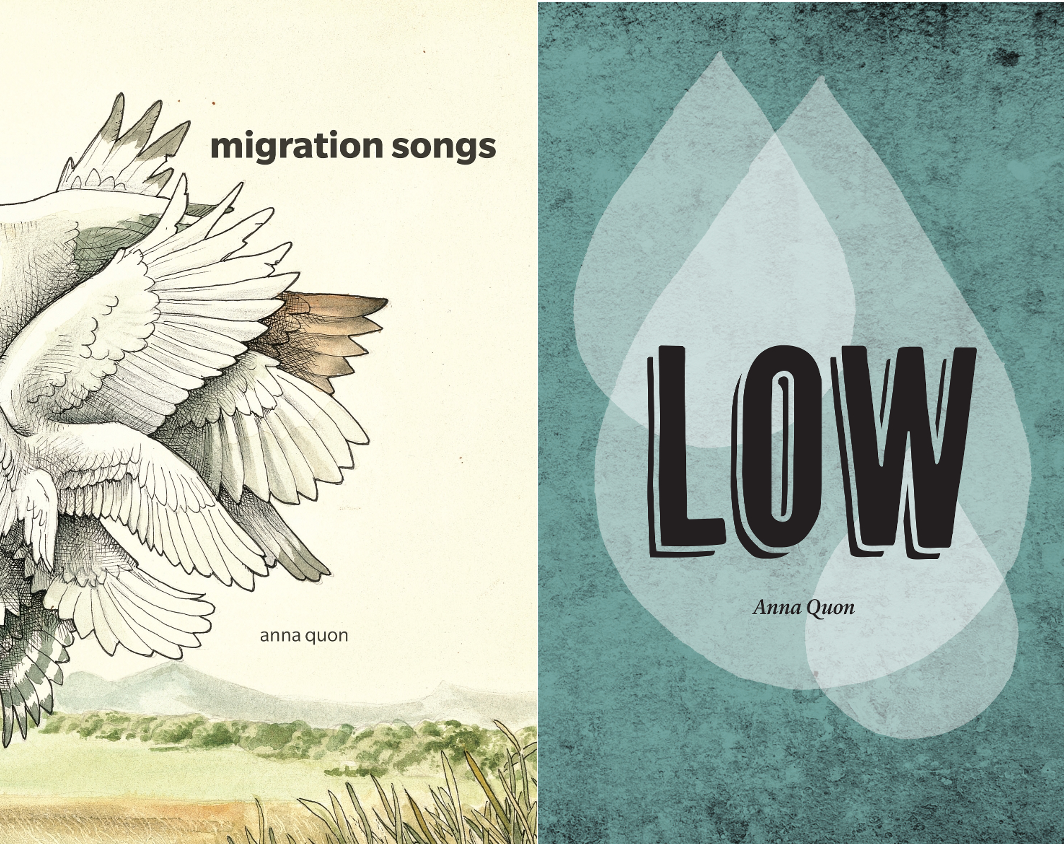
ROOM: Do you have a writing routine these days? Have you found that the pandemic has had an influence on your daily rhythms?
AQ: I generally try to write in the morning, when I have mental and physical energy. I often get up at 6 a.m., kind of dawdle around getting coffee, making breakfast, showering, and sit down at the desk at 8 a.m. (sometimes a lot later, sometimes a lot earlier). I write and fiddle around for two or, if lucky, three hours. That’s about all I have in me. I don’t write every day, except if I have a specific project, but lately I always have a project. Deadlines help. Have someone else depend on me for something helps. Knowing I have to finish something to get paid helps. These are motivations, not inspiration, of course. I see myself as a worker, a working writer and artist and what I do is work, so I have to show up to do it in a fairly regular and consistent way to be able to say that. But I thrive on projects with an end in sight. If I just had an endless life of writing ahead of me with no particular goal, I might feel pretty trapped.
The pandemic has actually given me more time and often more headspace to do creative work. The time I would have spent commuting to part-time work and trying to find some steady little contracts, I put toward writing grant applications and writing creatively. As far as my writing rhythm goes though, I am still inclined to write for a couple hours in the morning, but for most of the pandemic I had more time and space to think and dream about what would come next.
ROOM: What are you working on now?
AQ: At the moment, I am waiting to get my third novel back from the publisher for proofreading. I’m revising a one woman show that I wrote with the idea of performing it over Zoom—a Zoom theatre piece I call it. I’m trying to write a memoir, for which I’ve already completed a bunch of poems thanks in part to a Canada Council for the Arts grant I received in 2016. That’s a very, very long-term project. When I get down to writing again, I’ll be working on more prose for that. And I’m the subject of a documentary for Accessible Media Inc, so did some writing and painting for that and several long days of filming so far. I’ll also do a little animation. Right now, there’s a little lull in the writing. I’m always thankful for a lull because it helps me to rest recharge my brain. I don’t really take vacations— I don’t love travelling any more, especially flying, and I don’t drive so mostly, I stay put in Halifax. But Halifax is a great city for someone like me, who wants natural beauty around them and cultural vibrancy, but avoids a lot of excitement. My down time is taking a walk, coffee with friends and lying on the couch Facebooking. That’s how I get through life and keep making things and writing.
